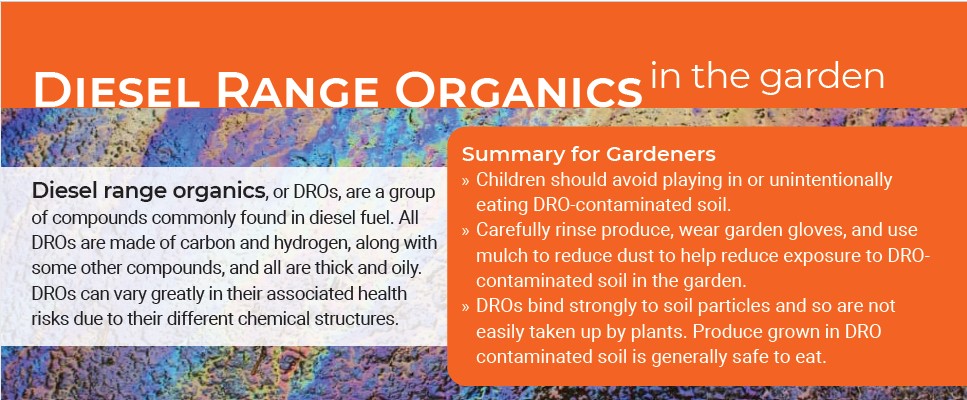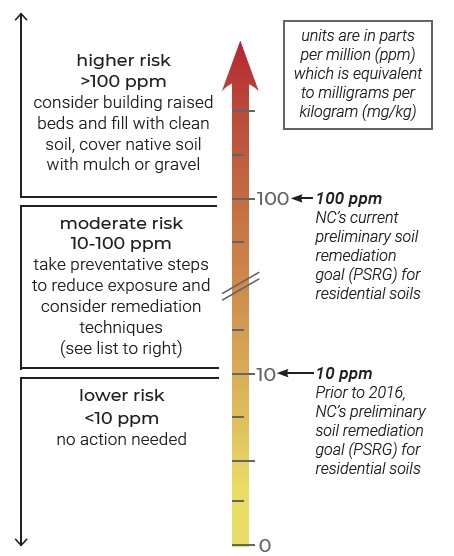Diesel Range Organics in the Garden
go.ncsu.edu/readext?824876
en Español / em Português
El inglés es el idioma de control de esta página. En la medida en que haya algún conflicto entre la traducción al inglés y la traducción, el inglés prevalece.
Al hacer clic en el enlace de traducción se activa un servicio de traducción gratuito para convertir la página al español. Al igual que con cualquier traducción por Internet, la conversión no es sensible al contexto y puede que no traduzca el texto en su significado original. NC State Extension no garantiza la exactitud del texto traducido. Por favor, tenga en cuenta que algunas aplicaciones y/o servicios pueden no funcionar como se espera cuando se traducen.
Português
Inglês é o idioma de controle desta página. Na medida que haja algum conflito entre o texto original em Inglês e a tradução, o Inglês prevalece.
Ao clicar no link de tradução, um serviço gratuito de tradução será ativado para converter a página para o Português. Como em qualquer tradução pela internet, a conversão não é sensivel ao contexto e pode não ocorrer a tradução para o significado orginal. O serviço de Extensão da Carolina do Norte (NC State Extension) não garante a exatidão do texto traduzido. Por favor, observe que algumas funções ou serviços podem não funcionar como esperado após a tradução.
English
English is the controlling language of this page. To the extent there is any conflict between the English text and the translation, English controls.
Clicking on the translation link activates a free translation service to convert the page to Spanish. As with any Internet translation, the conversion is not context-sensitive and may not translate the text to its original meaning. NC State Extension does not guarantee the accuracy of the translated text. Please note that some applications and/or services may not function as expected when translated.
Collapse ▲Making Sense of Regulatory Standards
No official standards have been established in North Carolina for an acceptable level of DROs in garden soils, specifically. The NC guidelines below (used to clean up old industrial sites) can help you determine whether DRO levels in your garden might need more attention.
Through testing, you may find DRO levels greater than 10 ppm. This does not mean that all of your garden soil is contaminated. Contamination “hotspots” can occur, and there are actions you can take.
Health Impacts of DROs
Continuous or frequent exposure to DROs or other petroleum-based compounds can increase your risk of health problems. Effects from exposure to DROs depend on their concentration in the soil, the frequency, and duration of exposure, as well as the specific types of DROs that are present in the soil.
Some DRO compounds are suspected to cause cancer. Other health effects include respiratory system effects such as lung inflammation or difficulty breathing, decreased liver and kidney function, neurological system effects, and eye damage. DRO- contaminated soil may also irritate the skin.
Reduce DRO Exposure in the Garden
— Take steps to prevent or limit stormwater from running off into your garden.
— Tilling the ground can help to limit DRO hotspots.
— Add compost or other organic matter from a contaminant-free source. Check the NC Composting Council website to find STA or OMRI certified compost.
— If you decide to build raised beds in your garden, make sure to place landscape fabric between the ground and the new soil in order to strengthen the separation barrier.
— Conduct a soil safety training to teach exposure reduction strategies to all garden users.
— Visit our website below for our factsheet on 10 Healthy Garden Habits.
 |
|
 |
How to test your soil and interpret the results |
 |
Still have questions about testing soil for DROs? Email us at superfund@duke.edu |
This factsheet was created by the Duke University Superfund Research Center’s Community Engagement Core with the goal of helping garden managers, Extension agents, Master Gardeners, and home gardeners identify, understand, and manage risks associated with chemical contamination that may be present in garden soils.
This work was supported through the National Institute of Environmental Health Sciences P42 Multiproject Center Grant program, grant number P42ES010356.









